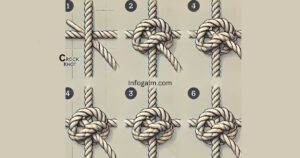Knot tying is an essential skill that has applications in various aspects of daily life—from outdoor adventures to simple tasks around the house. One knot that stands out for its reliability and versatility is the Crock Knot. Whether you’re an experienced outdoorsman, a crafter, or just looking to add to your skill set, the Crock Knot is a knot worth mastering. In this comprehensive guide, we’ll dive into what makes the Crock Knot special, how to tie it, and the various ways it can be put to use.
What is the Crock Knot?
It is a type of binding knot, primarily used to secure objects together or fasten a rope tightly around an object. Known for its strength and non-slip qualities, the Crock Knot is perfect for scenarios where you need a secure and reliable hold. While it shares similarities with well-known knots like the Square Knot and Clove Hitch, they offers distinct advantages that make it particularly useful in both recreational and practical settings.
The Origins of the Crock Knot
Though the exact origins of the it are unclear, it has been used across various cultures for centuries. The knot has been widely applied in traditional crafts like basket weaving and macramé, where tightly securing materials is essential. Its adaptability and strength have also made it a favorite among sailors, campers, and survivalists, highlighting its widespread use in both historical and modern contexts.
How to Tie a Crock Knot: A Step-by-Step Guide
One of the greatest advantages of the Crock Knot is its simplicity. Below is a detailed guide on how to tie this reliable knot:
Step 1: Create a Loop
Begin by making a loop with the rope or cord. This loop will serve as the foundation for the knot.
Step 2: Thread the Working End
Pass the working end (the end you’ll be manipulating) through the loop you’ve just created.
Step 3: Wrap Around the Standing Part
Wrap the working end tightly around the standing part of the rope (the stationary portion). The tension of this wrap will help secure the knot.
Step 4: Pass Through the Loop Again
After wrapping, pass the working end through the loop a second time. This ensures that the knot locks into place and minimizes the risk of slippage.
Step 5: Tighten the Knot
Pull firmly on the working end to tighten the knot. Make sure that the wraps are tight and secure.
Step 6: Test the Knot
Before using the knot, give it a test by applying some tension. If the knot holds without slipping, you’ve tied it correctly.

Common Uses for the Crock Knot
The it’s versatility makes it a go-to solution for numerous practical and recreational applications. Below are some of the most common uses for this knot:
1. Securing Bundles
It is frequently used to bind objects together securely. Whether you’re bundling firewood, fishing rods, or tent poles, the Crock Knot holds tightly and doesn’t slip, ensuring your items stay bound.
2. Outdoor Activities
Outdoor enthusiasts often rely on the Crock Knot for tasks like tying down tarps, securing gear to backpacks, or hanging clotheslines while camping. Its strength and simplicity make it an essential knot in the wilderness.
3. Sailing and Boating
In maritime settings, the Crock Knot is used to tie down sails, secure lines, and fasten equipment. Its resistance to slipping, even when wet, makes it a trusted tool for sailors.
4. Crafts and DIY Projects
The Crock Knot shines in crafts like macramé or basket weaving, where materials need to be held firmly in place. It’s also handy for DIY home projects where bundling or securing objects is necessary.
5. Temporary Repairs
It is perfect for quick fixes, like repairing a broken shoelace, tying a snapped strap, or temporarily securing a damaged piece of equipment.
Mastering the Crock Knot: Tips for Success
Although it is relatively simple to tie, mastering it takes practice and attention to detail. Here are some tips to help you refine your knot-tying skills:
1. Practice with Different Types of Rope
Experiment with various materials such as synthetic ropes, cotton cords, and paracord. Different materials may behave differently, so it’s important to know how the knot reacts in different scenarios.
2. Focus on Tight Wraps
The Crock Knot’s strength depends on the tension of its wraps. Always ensure the wraps are tight before pulling the knot closed to avoid slippage.
3. Use in Real-World Applications
The best way to perfect the Crock Knot is by using it in real-life situations. Whether it’s for outdoor activities, household tasks, or craft projects, regular use will help you become proficient.
4. Test the Knot Under Pressure
Before trusting the knot in a critical application, give it a good tug to test its strength. This practice will give you confidence in its reliability.
Comparing the Crock Knot to Other Popular Knots
The Crock Knot shares similarities with other popular knots, but it has distinct features that make it the best choice in certain situations.
1. Crock Knot vs. Square Knot
While both knots are used for securing bundles, the Square Knot is typically used to join two ends of a rope together. They, however, excels at binding a single rope around an object, offering greater security.
2. Crock Knot vs. Clove Hitch
The Clove Hitch is often used to fasten a rope to a post or similar object, but it can slip under tension. In contrast, it is less likely to slip, making it the superior choice for securing bundles that need to stay in place.
3. Crock Knot vs. Bowline
The Bowline Knot is widely used for creating a secure loop at the end of a rope, but it doesn’t provide the same level of binding power that they offers. For applications where holding materials together tightly is key, it is a better option.
Conclusion: The Crock Knot’s Versatility and Reliability
The Crock Knot is a powerful addition to any knot-tying repertoire. Its strength, ease of use, and versatility make it an essential tool for a wide range of activities. Whether you’re bundling materials, securing gear, or fixing a broken item, it is dependable and straightforward to master.
By learning it, you’re equipping yourself with a valuable skill that can be used in countless scenarios, from the campsite to the crafting table. With a little practice, you’ll find that it is a knot worth knowing and using in your everyday life.
FAQs
What is the Crock Knot used for?
It is primarily used for securing bundles of objects or fastening ropes around objects. It’s ideal for outdoor activities, crafts, and general-purpose use.
Is the Crock Knot easy to tie?
Yes, it is relatively simple to tie, making it a great choice for beginners and experienced knot enthusiasts alike.
Can I use the Crock Knot for sailing?
Absolutely! it is excellent for securing lines and tying down sails, especially since it holds well in wet conditions.
How does the Crock Knot differ from the Square Knot?
While both knots are used to secure objects, it is specifically designed for binding a single rope around an object, whereas the Square Knot is used to join two ropes.
Is the Crock Knot good for camping?
Yes, it is highly useful in camping scenarios, such as tying down tarps or securing gear.
Can the Crock Knot be used for temporary repairs?
Yes, it is perfect for quick fixes like tying a broken shoelace or securing a damaged strap.







